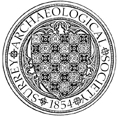Walton Heath, Walton-on-the-Hill
Observation by S Dyer, for SyAS, of disturbance caused by the excavation of a series of trenches for an irrigation system on the golf course, adjacent to the Roman villa. North of the villa site a concentration of Romano-British tile was observed but these may have been redeposited previously, to infill a hollow of some kind. Elsewhere a few sherds of greyware pottery were recovered. The disturbance was also observed by the BHRG who collected a quantity of Roman pottery, mainly 3rd century greywares, and also noted the concentration of tegula and imbrex tiles. (313)


